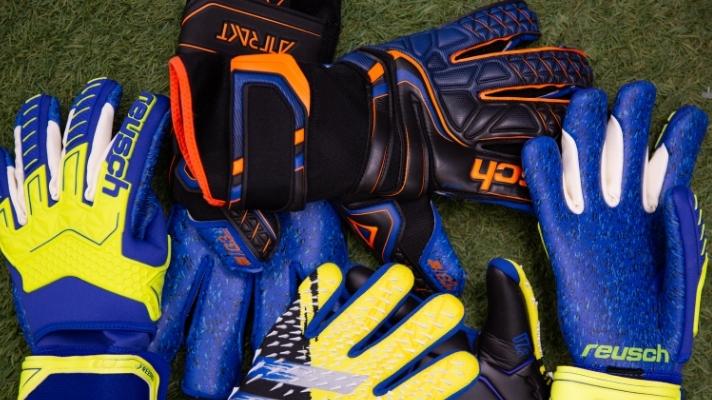How To Measure For Goalie Gloves
“How To Tell The Difference Between Player vs Fan Jerseys?”
Soccer goalkeepers have a challenging task, guarding their team’s net and stopping the opposition from scoring. They’re also the only position on the field that touches the ball with their hands when it enters their penalty area. Because a goalie is tasked with stopping a ball flying toward them, it is essential to have the right size gloves to prevent injury. Properly sized gloves allow the goalkeeper to have a good grip of the ball and support the fingers and wrists from bending too far.How Do You Pick Soccer Goalie Gloves?
Before looking into the details of goalie glove types and how to choose a good pair, remember that every goalkeeper’s hands are different. What works for Iker Casillas or Manuel Neuer may not necessarily work for you.
Before selecting a good pair of soccer goalie gloves, you must answer the following questions:
● What is your budget?
● How experienced are you?
● What are the dimensions of your hands and fingers?
● What are the playing conditions?
Once you know what you need, you can start looking for a pair of goalie gloves that best suits your needs.
What Makes a Good Goalie Glove?
The goalkeeper usually responds to opposing shots in one of two ways: Grabbing and taking control of the ball or deflecting it away, preferably toward a teammate. The goalkeeper’s gloves are specially constructed to let a goalkeeper perform these moves while protecting their fingers from injury.
The four parts of a goalie glove are:
● Backhand
The glove’s backhand is padded and reinforced to let a goalie punch or deflect the ball away from the net. Typically, the more expensive the glove, the higher the padding quality (more layers, more thickness, and latex padding instead of foam)
● Palm
The type and texture of the palms must facilitate the goalie’s ability to catch incoming balls and take control. There are three primary types of palm textures: Match, practice, and weather.
○ Match gloves have smooth latex palms with a high-strength gripping agent, facilitating the goalie’s job. They offer the highest grip but wear away the fastest, making them suitable for professional matches.
○ Practice gloves use dimpling or texturing instead, which provide less grip than the match gloves but have higher durability and are typically less expensive. They are ideal for practice, casual play, or beginners.
○ Weather gloves employ latex palms, like match gloves. However, the gripping agents they use are designed to become stickier when exposed to water, making them ideal for play under heavy rain and wind conditions.
● Fingers
Goalie glove fingers are reinforced with finger spines, designed to tighten when applying force, preventing the goalie’s fingers from over-extending or breaking. Finger spines can be segmented or flexible.
Segmented spines can bend forward but not backward, providing maximum protection at the cost of some flexibility. Flexible spines can bend in either direction, giving the goalie’s fingers more freedom of movement.
● Closure
The three most common closure types are bandage, hook-and-loop, and V-notch. There is no best choice here; it depends mainly on your preferences and the playing environment.
Bandage closures wrap around the goalie’s wrist like a sports bandage, maximizing wrist support. Hook-and-loop closures are adjustable, letting you choose how tightly or loosely you want them to fit. V-notch closures are ventilated, helping cool down the goalie’s hands and making them ideal for hot days.
How To Measure For Goalie Gloves?
The goalie glove size chart is as follows:
- Size 3: Youths 5-6, under 4’ tall
- Size 4: Youths 7-8, 4’-4’5” tall.
- Size 5: Youths 9-10, 4’5”-4’8” tall.
- Size 6: Youths 10-13, 4’8”-5’ tall.
- Size 7: Teenagers, 5’-5’3” tall.
- Size 8: Teenagers and adults, 5’3”-5’7” tall.
- Size 9: Teenagers and adults, 5’7”-5’10” tall.
- Size 10: Adults, 5’10”-6’2” tall.
- Size 11: Adults, 6’2”-6’5” tall.
- Size 12: Adults, 6’5” and taller.
The height ranges are estimations. If you want the highest comfort level, you should measure your hand dimensions and choose your size accordingly.
How Do You Measure Your Fingers?
The easiest way to measure your glove size is to measure the distance between your middle fingertip and the base of your palm.
Place your hand against a flat surface, palm up, and use a measuring tape to assess the distance from the tip of your middle finger to the bottom of your palm. Measure both hands; if you see a difference, choose gloves based on the larger size.
- Size 5: 3-4”
- Size 6: 4-5”
- Size 7: 5-6”
- Size 8: 6-7”
- Size 9: 7-8”
- Size 10: 8-9”
- Size 11: 9-10”
- Size 12: 10”-11”
Alternatively, measure the circumference of your palm at the widest part (around the interdigital pads) in inches. Round up to the next highest round number, then add 1; the result is your glove size.
- Example: If your palm circumference is 7.7 inches, round up to the next highest number (8) and add 1. Your glove size should be 9.
How to Select the Right Glove Cut?
The cut of a glove refers to the way its elements are stitched together. Different cuts offer varying levels of comfort, fit, flexibility, and dexterity. Although there is no best cut, there are cuts you may find more comfortable than others.
● Flat cut
The gussets are on the outside, giving these gloves a loose feel. Flat-cuts are inexpensive, making them ideal for beginners or casual play.
● Roll finger
This cut features latex panels rolled around the fingers and no gussets. Although somewhat loose-fitting, they give high finger comfort.
● Negative cut
Although they are gusseted like flat-cut gloves, the stitching is on the inside of the glove, offering maximum dexterity. However, they are typically the most expensive.
● Hybrid cut
Hybrid cut refers to a broad category for goalie gloves employing elements from other cut types. Although they are pricey, experimenting with a pair of hybrids may be what you need if standard glove cuts don’t fit you perfectly.
Shop Soccer Equipment at ProSoccer.com
At ProSoccer.com, we make shopping for soccer apparel and equipment easy. Whether you’re a goalie or a field player, browse our selection of top-rated footwear, apparel, and other equipment to invest in yourself and stay on top of the game.
Need Help Finding Your Goalie Glove?
You can always call us, talk to us via our website live chat or simply stop by our Pasadena, CA location if you're in town. Our knowledgeable team will be happy to answer all your questions about how to measure your goalie gloves and find the glove that fits just right!
Share on:





























